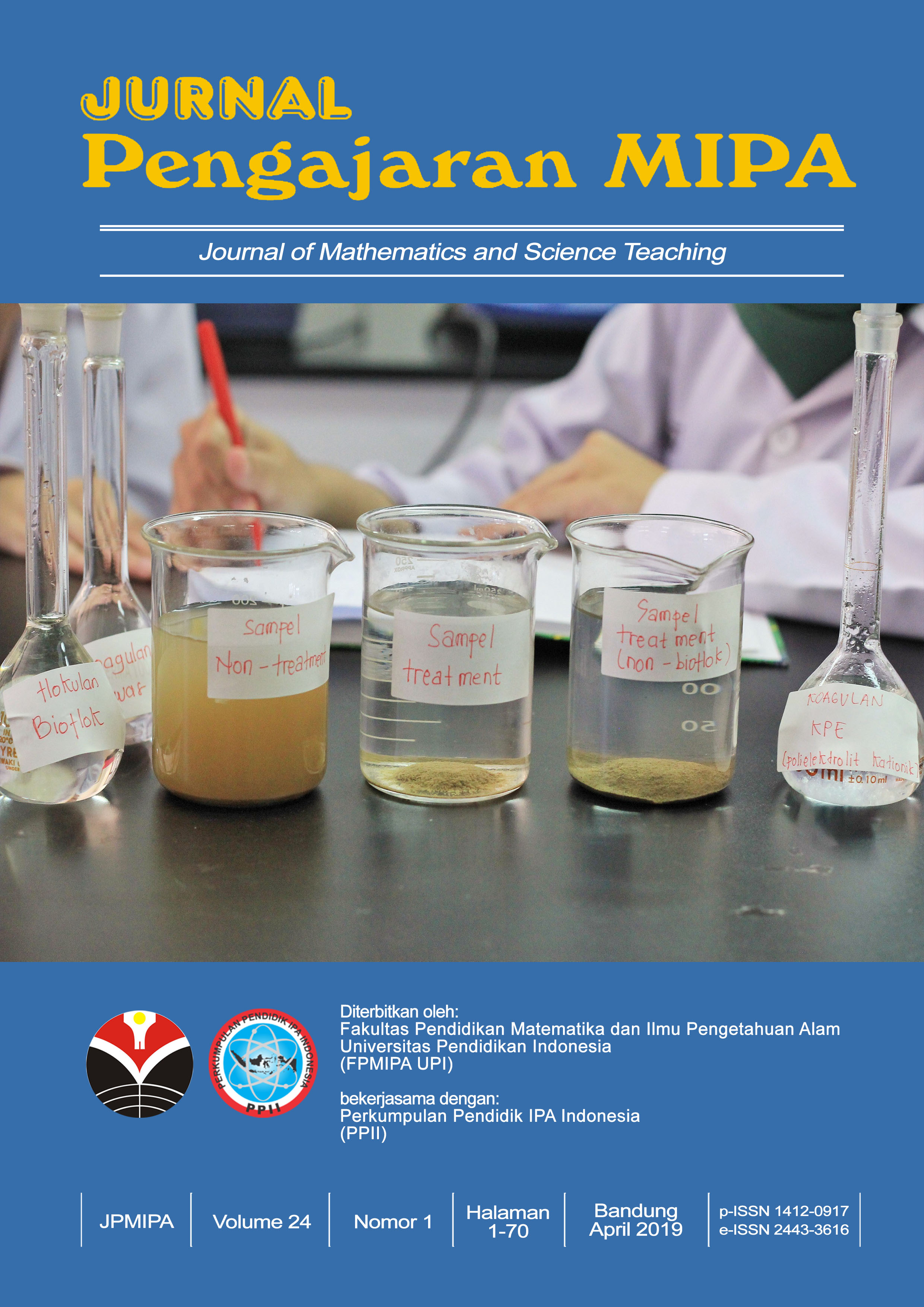LEARNING RESPIRATORY SYSTEM THROUGH MULTIPLE REPRESENTATION: CHALLENGE TO ENHANCE REASONING SKILL
Abstract
Keywords
References
Ainsworth, S. (1999). The functions of multiple representations. Computers & Education, 33(2–3), 131–152. https://doi.org/10.1016/S0360-1315(99)00029-9
Ainsworth, S. (2006). DeFT: A conceptual framework for considering learning with multiple representations. Learning and Instruction, 16(3), 183–198. https://doi.org/10.1016/j.learninstruc.2006.03.001
Anderson, D. (2005). Peirce and the art of reasoning. Studies in Philosophy and Education, 24(3–4), 277–289. https://doi.org/10.1007/s11217-005-3849-9
Ariës, R. J., Groot, W., & Van Den Brink, H. M. (2015). Improving reasoning skills in secondary history education by working memory training. British Educational Research Journal, 41(2), 210–228. https://doi.org/10.1002/berj.3142
Dawson, V., & Venville, G. J. (2009). High-school students’ informal reasoning and argumentation about biotechnology: An indicator of scientific literacy? International Journal of Science Education, 31(11), 1421–1445. https://doi.org/10.1080/09500690801992870
Erduran, S., & Jiménez-Aleixandre, M. P. (2008). Argumentation in science education. Perspectives from Classroom-Based Research. Dordre-Cht: Springer.
Gelder, T. van. (2005). Teaching critical thinking: Some lessons from cognitive science. College Teaching, 53(1), 41–48. https://doi.org/abs/10.3200/ctch.53.1.41-48
Gerber, B. L., Cavallo, A. M. L., & Marek, E. A. (2001). Relationships among informal learning environments, teaching procedures and scientific reasoning ability. International Journal of Science Education, 23(5), 535–549. https://doi.org/10.1080/09500690116971
Hahn, U., & Oaksford, M. (2007). The rationality of informal argumentation: A Bayesian approach to reasoning fallacies. Psychological Review, 114(3), 704. https://doi.org/10.1037/0033-295X.114.3.704
Hake, R. R. (1991). My Conversion to the Arons‐Advocated Method of science Education. Teaching Education, 3(2), 109–112. https://doi.org/10.1080/1047621910030211
Holyoak, K. J., & Morrison, R. G. (2005). The Cambridge Handbook of Thinking and Reasoning (1st ed.). Cambridge University Press.
Kirschner, P. A., Sweller, J., Kirschner, F., & Zambrano, J. (2018). From cognitive load theory to collaborative cognitive load theory. International Journal of Computer-Supported Collaborative Learning, 13(2), 213–233. https://doi.org/10.1007/s11412-018-9277-y
Liu, L., & Hmelo‐Silver, C. E. (2009). Promoting complex systems learning through the use of conceptual representations in hypermedia. Journal of Research in Science Teaching: The Official Journal of the National Association for Research in Science Teaching, 46(9), 1023–1040. https://doi.org/abs/10.1002/tea.20297
Mcneill, K. L., Lizotte, D. J., Krajcik, J., & Marx, R. W. (2009). Supporting Students ’ Construction of Scientific Explanations by Fading Scaffolds in Instructional Materials Supporting Students ’ Construction of Scientific Explanations by Fading Scaffolds in Instructional Materials. East, 15(917350197), 153–191. https://doi.org/10.1207/s15327809jls1502
Okeefe, P. A., Letourneau, S. M., Homer, B. D., Schwartz, R. N., & Plass, J. L. (2014). Learning from multiple representations: An examination of fixation patterns in a science simulation. Computers in Human Behavior, 35(June), 234–242. https://doi.org/10.1016/j.chb.2014.02.040
Olesen, P. J., Westerberg, H., & Klingberg, T. (2004). Increased prefrontal and parietal activity after training of working memory. Nature Neuroscience, 7(1), 75.
Osborne, J., Erduran, S., & Simon, S. (2004). Enhancing the quality of argumentation in school science. Journal of Research in Science Teaching, 41(10), 994–1020. https://doi.org/10.1002/tea.20035
Rasul, S., Bukhsh, Q., & Batool, S. (2011). A study to analyze the effectiveness of audio visual aids in teaching learning process at university level. Procedia-Social and Behavioral Sciences, 28, 78–81. https://doi.org/10.1016/j.sbspro.2011.11.016
Rau, M. A., Aleven, V., & Rummel, N. (2017). Making connections among multiple graphical representations of fractions: sense-making competencies enhance perceptual fluency, but not vice versa. Instructional Science, 45(3), 331–357. https://doi.org/10.1007/s11251-017-9403-7
Renocha, P. D., Rochintaniawati, D., & Widodo, A. (2017). Junior High School Students’ Reasoning. Advances in Social Science, Education, and Humanities Research, 57(ICMSEd 2016), 2–6. https://doi.org/10.1186/1740-3391-2-4
Sadler, T. D., & Zeidler, D. L. (2005). Patterns of informal reasoning in the context of socioscientific decision making. Journal of Research in Science Teaching: The Official Journal of the National Association for Research in Science Teaching, 42(1), 112–138. https://doi.org/abs/10.1002/tea.20042
Simon, S. (2008). Using Toulmin’s Argument Pattern in the evaluation of argumentation in school science. International Journal of Research and Method in Education, 31(3), 277–289. https://doi.org/10.1080/17437270802417176
Sweller, J., Ayres, P., & Kalyuga, S. (2011). Cognitive load theory. Springer. https://doi.org/10.1007/978-1-4419-8126-4_18
Tsui, C.-Y., & Treagust, D. F. (2013). Introduction to multiple representations: Their importance in biology and biological education. In Multiple representations in biological education (pp. 3–18). Springer. https://doi.org/https://doi.org/10.1007/978-94-007-4192-8_1
Waldrip, B., & Prain, V. (2012). Reasoning through representing in school science. Teaching Science: The Journal of the Australian Science Teachers Association, 58(4). https://doi.org/10.3316/aeipt.203254
DOI: https://doi.org/10.18269/jpmipa.v27i1.38938
Refbacks
- There are currently no refbacks.
Copyright (c) 2022 Jurnal Pengajaran MIPA

This work is licensed under a Creative Commons Attribution-ShareAlike 4.0 International License.
JPMIPA http://ejournal.upi.edu/index.php/jpmipa/index is licensed under a Creative Commons Attribution-ShareAlike 4.0 International License
Jurnal Pengajaran Matematika dan Ilmu Pengetahuan Alam (JPMIPA) or Journal of Mathematics and Science Teaching
All rights reserverd. pISSN 1412-0917 eISSN 2443-3616
Copyright © Faculty of Mathematics and Science Education (FPMIPA) Universitas Pendidikan Indonesia (UPI)
View JPMIPA Stats









